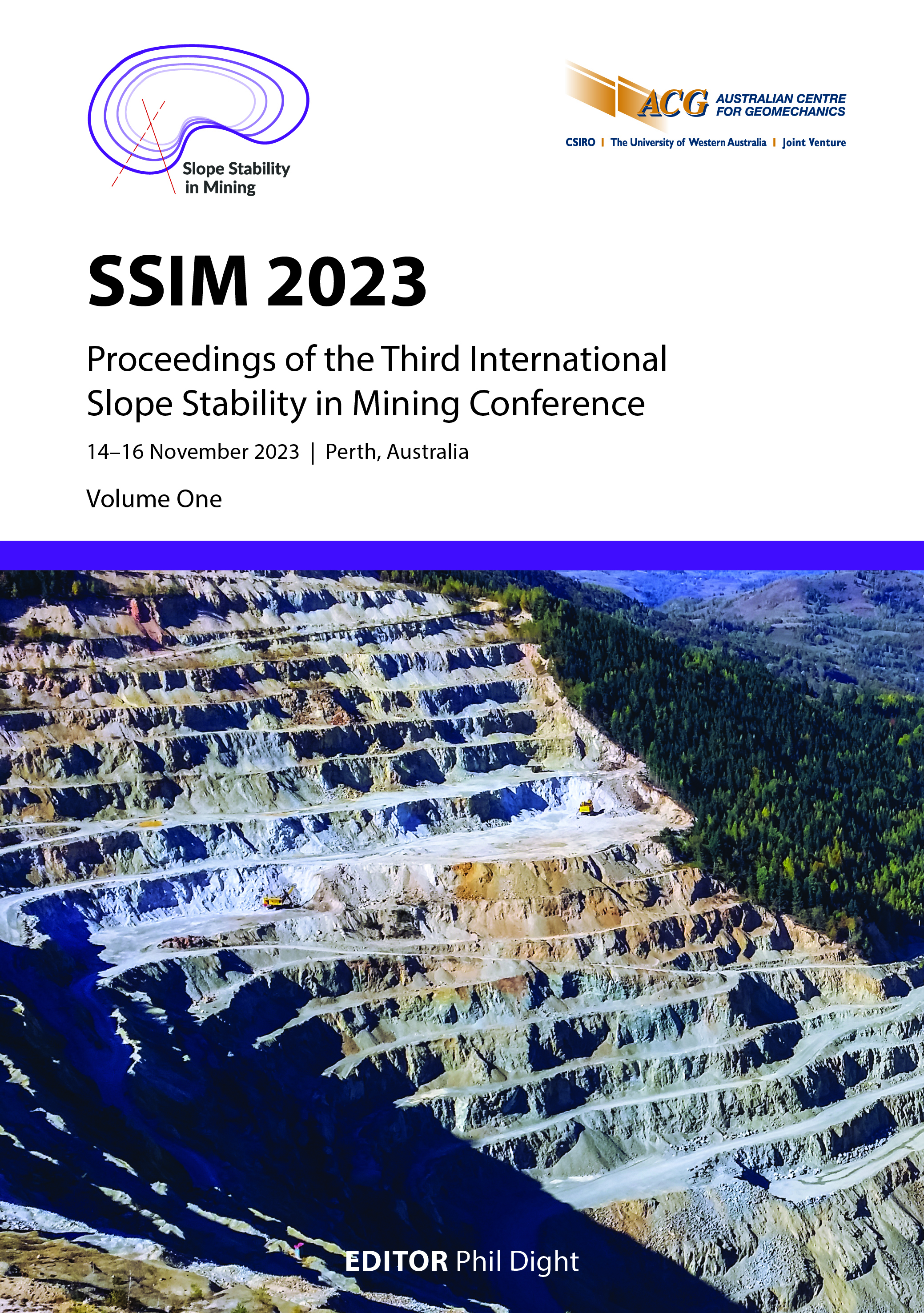Factors impacting and controlling water erosion of rock benches and slopes

|
Authors: Baczynski, NRP; Bar, N; Firouz, NC |
DOI https://doi.org/10.36487/ACG_repo/2335_61
Cite As:
Baczynski, NRP, Bar, N & Firouz, NC 2023, 'Factors impacting and controlling water erosion of rock benches and slopes', in PM Dight (ed.), SSIM 2023: Third International Slope Stability in Mining Conference, Australian Centre for Geomechanics, Perth, pp. 883-904, https://doi.org/10.36487/ACG_repo/2335_61
Abstract:
Rock slope faces typically comprise assemblages of benches intended to catch dislodged rock debris, channel groundwater and rainfall runoff along slope faces, and flatten overall slopes to design angles. Excavation of neat design-width benches is often not achieved as planned. If bench widths are reduced by adverse structure and/or poor blasting, or if their surfaces lack the required gradients for water flow and discharge at selected locations, runoff cascades over bench crests. If sufficient geological defects data exist, then risk of partial to entire bench height and akin berm width instabilities can be statistically quantified. These risks are often rocktype and slope-facing direction-dependent. In existing pits, such risks can also be estimated either by stereopair slope photography done from suitable vantage points around the pit or by drone flyover inspection of slope faces, but single- and multiple-event (i.e. progressive failure) structural, and poor blasting, failures are often difficult to distinguish and quantify. Water runoff over bench crests often occurs along major faults and zones of weak ground. Such discharge erodes geological defects to establish narrow slots that rapidly enlarge and coalesce into major V-shape chasms on slopes; with voids at some mines being 150 m along strike, 80 m deep and 300 m high, and with their debris runout exceeding 100 m. To avoid chasms, preventative measures are installed at time of bench mining. Remedial works are undertaken after some erosion occurs. The management decision to install preventative measures is dictated by site-specific experience and based on good appreciation of the safety and mining consequences if slope void development is not prevented. Reinstating bench drainage across large chasms is impossible; water needs diversion around such chasm footprints. Once established, considerable ongoing remedial effort is required to arrest or to retard the rate of chasm expansion. Stability monitoring alone does not solve the problem, but does provide safer working conditions. Examples of defect-controlled bench stability risks are presented. The stability impact of water runoff erosion is illustrated by examples from Australian and overseas mines. The general decision process, use of risk matrices, advantages, disadvantages, and the durability, difficulty and timing of water erosion preventative (geotextile on bench faces and high-density polyethylene, mesh with shotcrete in water drains) and remedial works (void rock backfill, toe buttress, gabion basket wall, pit floor bund and slope cutback) are discussed.
Keywords: benches, blasting, adverse defects, water erosion, preventative and remedial measures
References:
Baczynski, NRP 2016, ‘Rock slope stability risks’, in PM Dight (ed.), APSSIM 2016: Proceedings of the First Asia Pacific Slope Stability in Mining Conference, Australian Centre for Geomechanics, Perth, pp. 469–484,
/1604_30_Baczynski
Baczynski, NR 2023, ‘Adjusted GSI for directional Hoek–Brown strength of jointed rock mass’, ANZgeo2023: Proceedings of the Fourteenth Australian and New Zealand Conference on Geomechanics.
Bar, N, Kuira, P & Semi, J 2014, ‘Managing risk associated with erosion-driven slope instabilities with ground support and surface water management in a high rainfall environment at Ok Tedi Copper-Gold Mine’, Proceedings of Engineers Australia: Mastering Complex Projects Conference 2014, Engineers Australia, Barton.
Bar, N, Parker, R & Thomas, SJ 2016, ‘Managing landslide risks associated with erosion-driven slope instabilities using near real-time deformation monitoring systems’, Eurock 2016, Proceedings of ISRM International Symposium, CRC Press, Leiden,
pp. 1191–1196.
Little, TN, Cortes, JP & Baczynski, NR 1998, Executive Summary: Final Report, OTML Internal Report, Risk-based Slope Design Optimization Study for the Ok Tedi Copper-gold Mine in PNG, Mine Technical Services Department, Geotechnical Engineering Section, 15 p.
Little, TN, Cortes, JP & Baczynski, NR 1999, Probabilistic Design Analysis and Sensitivity Studies, OTML Internal Report, Risk-based Slope Design Optimization Study for the Ok Tedi Copper-gold Mine in PNG, vol. 7, Mine Technical Services Department, Geotechnical Engineering Section, 198 p.
Little, TN, Cortes, JP & Baczynski, NR 2000, Risk-based Slope Design Optimization, OTML Internal Report, Risk-based Slope Design Optimization Study for the Ok Tedi Copper-gold Mine in PNG, vol. 8, Mine Technical Services Department, Geotechnical Engineering Section, 159 p.
Nguyen, N, Dempers, G, Seymour, C & Harris, M 2023, Using drone photogrammetry to optimise geotechnical analysis through efficient data collection, SSIM2023: Proceedings of the 3rd International Slope Stability in Mining Conference, Australian Centre for Geomechanics, Perth, pp. 589–602.
© Copyright 2024, Australian Centre for Geomechanics (ACG), The University of Western Australia. All rights reserved.
View copyright/legal information
Please direct any queries or error reports to repository-acg@uwa.edu.au
View copyright/legal information
Please direct any queries or error reports to repository-acg@uwa.edu.au

